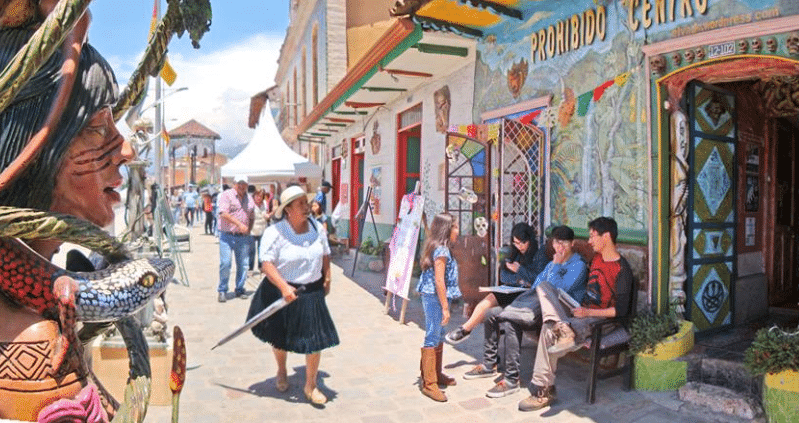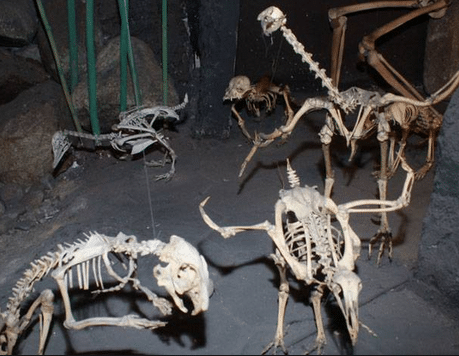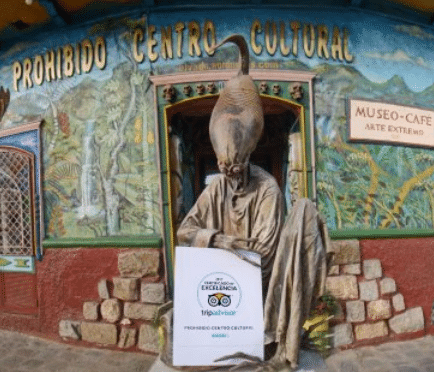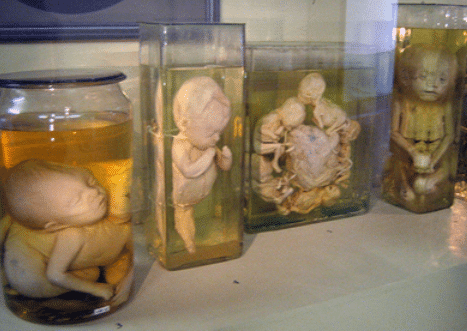Cuenca’s weird museums

By Tom Larsen
Everyone, whether they’re a visitor or a long-time resident of Cuenca, should see all the wonderful sights that the city has to offer — the New and Old Cathedrals, Parque Calderon, the Flower Market, Todos Santos Church—the list goes on and on. But, maybe you’ve seen all of these, or maybe you have a taste for things that are little less orthodox, a little stranger perhaps.

Skeletons on the prowl on Simon Bolivar.
If that’s the case, then these three weird little museums are for you.
Museo del Esquetelogia (Skeleton Museum)
This little gem on Simón Bolívar, across from Iglesia San Alfonso, is the brainchild of Doctor Gabriel Espinosa Moscoso, a prominent early twentieth-century scientist, who spent nearly forty years collecting skeletons of Ecuadorian fauna. The skeletons range in size from that of a baby African elephant (the only non-native animal in the museum) to a tiny Andean wren. One diorama contains a human skeleton surrounded by the skeletons of a cat, a dog, a duck, a chicken and a turkey, highlighting their similarities and differences. A two-toed sloth hangs upside down from a tree branch, just as in nature, and the tiny, almost translucent bones of a Fruit Bat give a testimony to the patience and skill that Dr. Moscoso possessed.
Each exhibit is accompanied by a small placard that gives some information about the particular skeleton and its importance. One display shows a series of human skulls from age six-months to 42 years, giving a great visual of how our skulls develop and change over time.
The museum had fallen into disrepair and was rarely open, but is now run by Moscoso’s great-granddaughter, who hopes the museum will contribute to environmental awareness. Rather than being a heavy-handed lecture on the subject of skeletons, the museum aims to be entertaining first, allowing the visitor to form their own opinions.
Simon Bolívar 6-75 y Presidente Borrero. Monday to Friday: 10 am to 1:30 pm. Admission: $2. Tel: 7-282-1150
Prohibido Centro Cultural (Forbidden Cultural Center)
The Forbidden Cultural Center opened in February 1996 as the gallery of the artist Eduardo Moscoso, with the aim of supporting artists of alternative cultural expression. It’s another museum run by a descendant of the original owner, in this case Moscoso’s son.

Entrance to Prohibido Cultural on Peotonal de La Condamine.
From their Blog page (prohibidocc. wordpress.com): “The infrastructure of the gallery is adapted to perform events of musical character or performance. It is also used as a museum for exhibition of works. Currently they work with national and international artists, in their different expressions such as: Performing Arts, Visual Arts, Musical Arts, Audiovisual, etc.
“It is a place dedicated to the support and diffusion of all the alternative cultural manifestations in their different genres of expression: music, theatre, painting, sculpture, video art, etc.”
That may be an understatement. Displays include a papal figure in a tomb beneath the floor, as well as a painting (by the original owner) of a man poling a raft high above the jungle, surrounded in the air by snakes, tropical fish and odd-looking birds. Don’t miss the small concrete wash sink in the back corner of the room — interesting to say the least.
The museum also hosts musical events. I happened to be there the day a metal band was warming up in a room perhaps one-third the size of the Vegetable Bar. A (hopefully) once in a lifetime experience.
Calle Peotonal de La Condamine Monday to Saturday: 9 am to 9 pm. Sunday: 9 am to 2 pm. Admission: $1 (for locals). Tel: 7-284-0703

Specimens on display at the Medical Museum.
Museo Historia de la Medicina (Medical History Museum)
The two-story Museo Historia de la Medicina Guillermo Aguilar M. on Av. 12 de Abril, just east of Av. Solano, occupies the former San Vicente de Pablo Hospital, which dates back to 1876. The museum was founded in 1982 and underwent a renovation, begun in 1984, before opening to the public in in 1996. There are nearly 10,000 items on display that were in use during the period 1895 to 1970.
Many of the tools and devices that were no doubt state of the art at the time, now resemble instruments of torture, perhaps most glaringly, the birthing chair for expectant mothers, from the early 1900s.
As you walk around, try to imagine an operating room nurse sterilizing surgical instruments in a wood-fired autoclave, or administering anesthesia from a device resembling a scale model of a spaceship from a bad 1940s sci-fi movie.
If you hate going to the dentist now, stroll through the room featuring dental tools from the early days of the twentieth century. Many of the tools would not have been out of place in your grandfather’s metal shop.
The jar containing the fetuses of unborn twins is particularly disturbing, and, for a sobering experience, take a few minutes to examine the ancient iron lung that sits in the courtyard.
Av. 12 de Abril, across from the Benigno Malo Bridge. Monday to Friday 8 am to 5 pm. Admission: $1
You should probably allow one-half hour each for the Skeleton Museum and the Prohibited Cultural Center, and as much as 1-1/2 hours for the Medical History Museum. They are located within an easy 20-minute walk from one another, so you can hit them all in a leisurely morning or afternoon, and spend less than $5 total.
A word of warning: These opening hours and costs are accurate as of this writing, but things in Cuenca change quickly, and without warning.




















